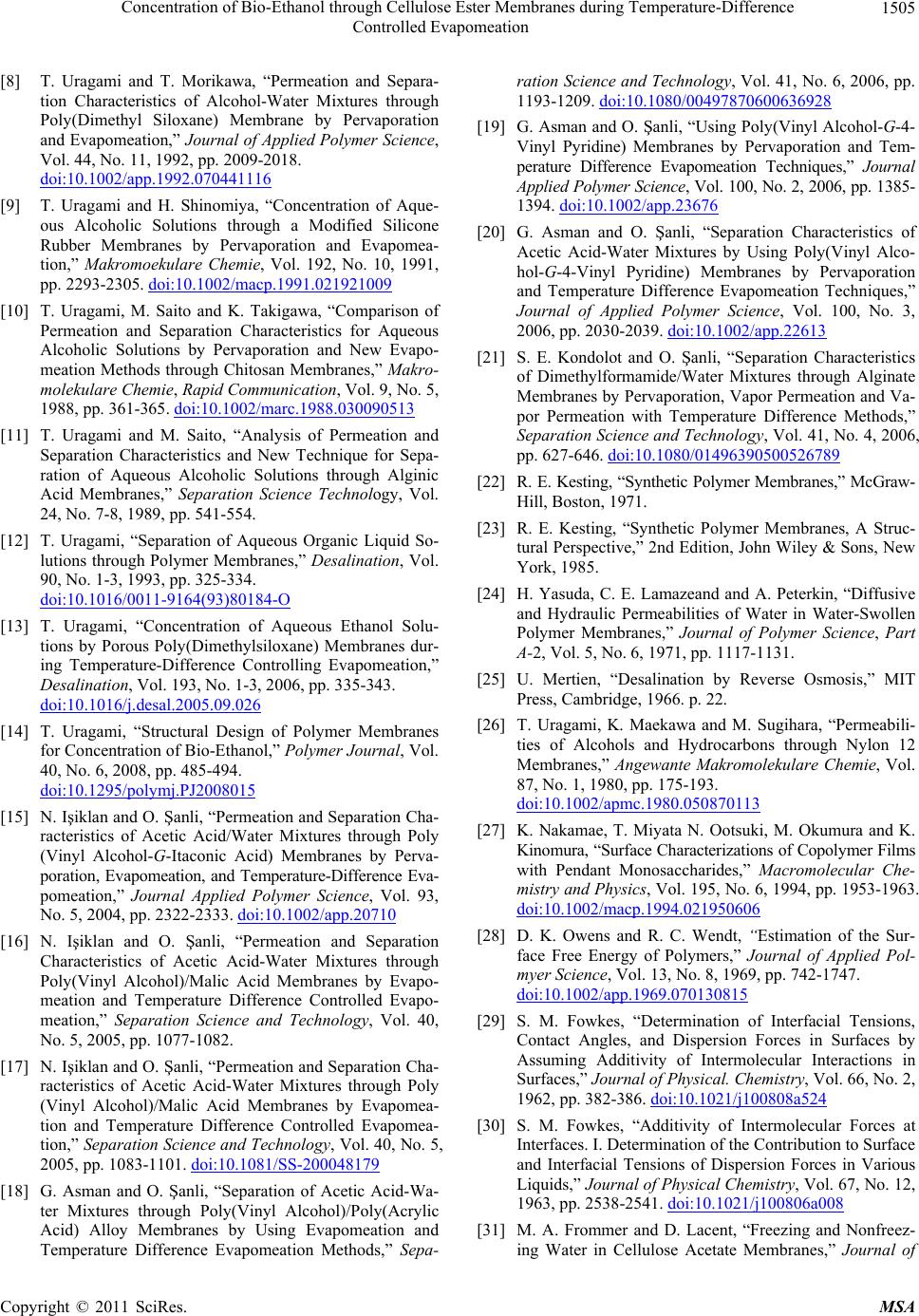
Concentration of Bio-Ethanol through Cellulose Ester Membranes during Temperature-Difference 1505
Controlled Evapomeation
[8] T. Uragami and T. Morikawa, “Permeation and Separa-
tion Characteristics of Alcohol-Water Mixtures through
Poly(Dimethyl Siloxane) Membrane by Pervaporation
and Evapomeation,” Journal of Applied Polymer Science,
Vol. 44, No. 11, 1992, pp. 2009-2018.
doi:10.1002/app.1992.070441116
[9] T. Uragami and H. Shinomiya, “Concentration of Aque-
ous Alcoholic Solutions through a Modified Silicone
Rubber Membranes by Pervaporation and Evapomea-
tion,” Makromoekulare Chemie, Vol. 192, No. 10, 1991,
pp. 2293-2305. doi:10.1002/macp.1991.021921009
[10] T. Uragami, M. Saito and K. Takigawa, “Comparison of
Permeation and Separation Characteristics for Aqueous
Alcoholic Solutions by Pervaporation and New Evapo-
meation Methods through Chitosan Membranes,” Makro-
molekulare Chemie, Rapid Communication, Vol. 9, No. 5,
1988, pp. 361-365. doi:10.1002/marc.1988.030090513
[11] T. Uragami and M. Saito, “Analysis of Permeation and
Separation Characteristics and New Technique for Sepa-
ration of Aqueous Alcoholic Solutions through Alginic
Acid Membranes,” Separation Science Technology, Vol.
24, No. 7-8, 1989, pp. 541-554.
[12] T. Uragami, “Separation of Aqueous Organic Liquid So-
lutions through Polymer Membranes,” Desalination, Vol.
90, No. 1-3, 1993, pp. 325-334.
doi:10.1016/0011-9164(93)80184-O
[13] T. Uragami, “Concentration of Aqueous Ethanol Solu-
tions by Porous Poly(Dimethylsiloxane) Membranes dur-
ing Temperature-Difference Controlling Evapomeation,”
Desalination, Vol. 193, No. 1-3, 2006, pp. 335-343.
doi:10.1016/j.desal.2005.09.026
[14] T. Uragami, “Structural Design of Polymer Membranes
for Concentration of Bio-Ethanol,” Polymer Journal, Vol.
40, No. 6, 2008, pp. 485-494.
doi:10.1295/polymj.PJ2008015
[15] N. Işiklan and O. Şanli, “Permeation and Separation Cha-
racteristics of Acetic Acid/Water Mixtures through Poly
(Vinyl Alcohol-G-Itaconic Acid) Membranes by Perva-
poration, Evapomeation, and Temperature-Difference Eva-
pomeation,” Journal Applied Polymer Science, Vol. 93,
No. 5, 2004, pp. 2322-2333. doi:10.1002/app.20710
[16] N. Işiklan and O. Şanli, “Permeation and Separation
Characteristics of Acetic Acid-Water Mixtures through
Poly(Vinyl Alcohol)/Malic Acid Membranes by Evapo-
meation and Temperature Difference Controlled Evapo-
meation,” Separation Science and Technology, Vol. 40,
No. 5, 2005, pp. 1077-1082.
[17] N. Işiklan and O. Şanli, “Permeation and Separation Cha-
racteristics of Acetic Acid-Water Mixtures through Poly
(Vinyl Alcohol)/Malic Acid Membranes by Evapomea-
tion and Temperature Difference Controlled Evapomea-
tion,” Separation Science and Technology, Vol. 40, No. 5,
2005, pp. 1083-1101. doi:10.1081/SS-200048179
[18] G. Asman and O. Şanli, “Separation of Acetic Acid-Wa-
ter Mixtures through Poly(Vinyl Alcohol)/Poly(Acrylic
Acid) Alloy Membranes by Using Evapomeation and
Temperature Difference Evapomeation Methods,” Sepa-
ration Science and Technology, Vol. 41, No. 6, 2006, pp.
1193-1209. doi:10.1080/00497870600636928
[19] G. Asman and O. Şanli, “Using Poly(Vinyl Alcohol-G-4-
Vinyl Pyridine) Membranes by Pervaporation and Tem-
perature Difference Evapomeation Techniques,” Journal
Applied Polymer Science, Vol. 100, No. 2, 2006, pp. 1385-
1394. doi:10.1002/app.23676
[20] G. Asman and O. Şanli, “Separation Characteristics of
Acetic Acid-Water Mixtures by Using Poly(Vinyl Alco-
hol-G-4-Vinyl Pyridine) Membranes by Pervaporation
and Temperature Difference Evapomeation Techniques,”
Journal of Applied Polymer Science, Vol. 100, No. 3,
2006, pp. 2030-2039. doi:10.1002/app.22613
[21] S. E. Kondolot and O. Şanli, “Separation Characteristics
of Dimethylformamide/Water Mixtures through Alginate
Membranes by Pervaporation, Vapor Permeation and Va-
por Permeation with Temperature Difference Methods,”
Separation Science and Technology, Vol. 41, No. 4, 2006,
pp. 627-646. doi:10.1080/01496390500526789
[22] R. E. Kesting, “Synthetic Polymer Membranes,” McGraw-
Hill, Boston, 1971.
[23] R. E. Kesting, “Synthetic Polymer Membranes, A Struc-
tural Perspective,” 2nd Edition, John Wiley & Sons, New
York, 1985.
[24] H. Yasuda, C. E. Lamazeand and A. Peterkin, “Diffusive
and Hydraulic Permeabilities of Water in Water-Swollen
Polymer Membranes,” Journal of Polymer Science, Part
A-2, Vol. 5, No. 6, 1971, pp. 1117-1131.
[25] U. Mertien, “Desalination by Reverse Osmosis,” MIT
Press, Cambridge, 1966. p. 22.
[26] T. Uragami, K. Maekawa and M. Sugihara, “Permeabili-
ties of Alcohols and Hydrocarbons through Nylon 12
Membranes,” Angewante Makromolekulare Chemie, Vol.
87, No. 1, 1980, pp. 175-193.
doi:10.1002/apmc.1980.050870113
[27] K. Nakamae, T. Miyata N. Ootsuki, M. Okumura and K.
Kinomura, “Surface Characterizations of Copolymer Films
with Pendant Monosaccharides,” Macromolecular Che-
mistry and Physics, Vol. 195, No. 6, 1994, pp. 1953-1963.
doi:10.1002/macp.1994.021950606
[28] D. K. Owens and R. C. Wendt, “Estimation of the Sur-
face Free Energy of Polymers,” Journal of Applied Pol-
myer Science, Vol. 13, No. 8, 1969, pp. 742-1747.
doi:10.1002/app.1969.070130815
[29] S. M. Fowkes, “Determination of Interfacial Tensions,
Contact Angles, and Dispersion Forces in Surfaces by
Assuming Additivity of Intermolecular Interactions in
Surfaces,” Journal of Physical. Chemistry, Vol. 66, No. 2,
1962, pp. 382-386. doi:10.1021/j100808a524
[30] S. M. Fowkes, “Additivity of Intermolecular Forces at
Interfaces. I. Determination of the Contribution to Surface
and Interfacial Tensions of Dispersion Forces in Various
Liquids,” Journal of Physical Chemistry, Vol. 67, No. 12,
1963, pp. 2538-2541. doi:10.1021/j100806a008
[31] M. A. Frommer and D. Lacent, “Freezing and Nonfreez-
ing Water in Cellulose Acetate Membranes,” Journal of
Copyright © 2011 SciRes. MSA